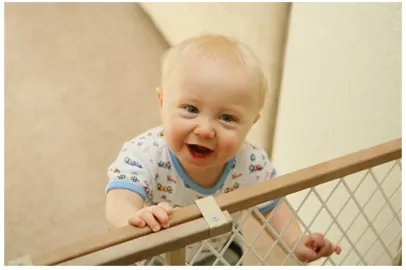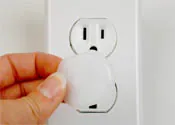A dream home is anything but average. Homeowners customize their dream homes to best suit their families in both day-to-day activities and milestone celebrations.

Everything looks perfect from where the grownups stand. However, it is important to take a second look – from the view of a small child, the home has more hazards than one may initially realize. Every year millions of children suffer injuries occurring in the home. More than 70% of these children are under the age of five and a number of these injuries even result in death.
Taking a few simple, but highly important, steps to childproof the home will help ensure your dream home is as safe as possible. Begin by getting on your child's level in every room of the house. Is there anything once thought safe that may pose a hazard from this new view? To prevent the most common injuries of falling, poisoning, burns and drowning, pay close attention to the following areas of safety:
-
Sharp Corners - Your favorite coffee table may cause frustration when you bump into it on occasion. However, from a child's point of view, that same table could result in a head injury rather than a bruised knee for the adults. Tables, cabinets, and other sharp corners should be securely fitted with guards or bumpers that round edges, softening bumps and falls.
-
Latches and Locks - Cleaning supplies, medicines, and other potential toxins should always be stored out of reach. Even so, all cabinets and drawers that could possibly be accessed by small hands should be fitted with child-safe locks or latches. These small additions keep little ones away from harmful substances and from making a game out of emptying all the cabinets. It may also be useful to designate one low cabinet for appropriate toy storage. Knowing they can access their own space can help keep curious kids out of other cabinets.

-
Electrical Outlets - Many homeowners are familiar with the small plastic covers that fit over electrical outlets. These are great in preventing young children from accidentally accessing outlets. However, children as young as three have been known to pry these covers from the outlets. If an outlet is rarely in use, it may be best to purchase hard covers that screw over the outlet plate. It is always a good idea to ask your local hardware stores for the newest recommendations in outlet safety.
-
Safety Gates - Safety gates are great at keeping children and pets from accessing entire rooms. Gates that screw into the walls are considered sturdier than pressure gates, but it is most important to look for the Juvenile Protection Manufacturers Association seal when purchasing a safe and easy-to-use gate.
-
Windows - Screens in windows are not in place to prevent falls. Where windows open and children are present, it is important to have safety nets or guards in place. Keep in mind that some safety treatments cannot be quickly removed so one window needs to be designated for emergency evacuation. Also, adjustable cords and safety tassels should be placed on all appropriate window treatments to prevent strangulation. When purchasing window treatments, ask about the available safety measures. Some are now built into the products or professionals can recommend the best safety measures for each product.
-
Appliances - Appliances on counter and tabletops are in danger of becoming falling hazards if not properly secured. Ensure that cords are not left to dangle and be pulled, buttons and knobs are not accessible from the front, and large appliances are anchored to the wall.
-
Water - Small children can drown in less than two inches of water and can be severely burned should temperatures rise above 120 degrees. Toilet locks and gauges to monitor water temperature are simple materials that can prevent terrible injuries.
-
Lighting - How often have you obnoxiously stubbed a toe in the dark or tripped on your shoes while working your way to the bathroom at night? For many children, the dark is more frightening than frustrating and can result in disorientation and accidents. Small nightlights along walkways create a reassuring path and highlight obtrusions without being intrusive to those sleeping.
These important safety precautions cannot be considered foolproof but go a long way in preventing common injuries. Remember that child proofing is ever changing just as your children are constantly growing and learning. Whatever age, keep emergency numbers posted by all phones, smoke detectors working, and a first aid kit stocked and easily accessible. Extra copies of house keys outside the house and CPR certification are also beneficial in being prepared for home emergencies. Common sense, quick reactions, and a few specialized tools can make your home as safe as you dream.
Here are some related articles:
Save this article to:
back to top